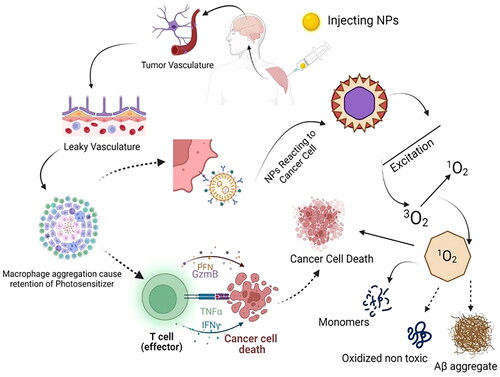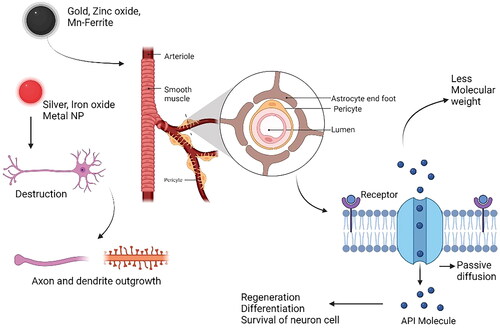Figures & data
Table 1. Characteristic features of the most common neurodegenerative disorders.
Figure 1. General mechanism of action in PDT to PS and different reactions leading to cell death. PS is exposed to light, which causes it to transform into an excited singlet state. Fluorescence emissions or non-radiative decay may be used to partially return to the ground state or undergo intersystem crossing to the excited triplet state. Two different kinds of chemical reactions then work to promote the production of ROS: type I reactions produce free radicals and radical ions through electron transfer reactions, and type II reactions involve the response of PS with molecular oxygen, where the energy is transferred to the triplet ground state of the molecular oxygen to produce singlet oxygen. ROS causes photodynamic effects on pathogenic bacteria or tumour cells (used for PDT) [Citation32].
![Figure 1. General mechanism of action in PDT to PS and different reactions leading to cell death. PS is exposed to light, which causes it to transform into an excited singlet state. Fluorescence emissions or non-radiative decay may be used to partially return to the ground state or undergo intersystem crossing to the excited triplet state. Two different kinds of chemical reactions then work to promote the production of ROS: type I reactions produce free radicals and radical ions through electron transfer reactions, and type II reactions involve the response of PS with molecular oxygen, where the energy is transferred to the triplet ground state of the molecular oxygen to produce singlet oxygen. ROS causes photodynamic effects on pathogenic bacteria or tumour cells (used for PDT) [Citation32].](/cms/asset/e9297eea-82ed-409d-9eb3-ffbaced0acb8/ianb_a_2304814_f0001_c.jpg)
Table 2. Distinct categories of PS and the malignancies to which they may be applied.
Table 3. Commonly applied ligands for polymeric coating of NPs for targeting the brain and improving BBB’s permeability.
Figure 2. Schematic illustration of organic and inorganic NPs used for nanotherapeutics or nano-drug products. (Illustration created with BioRender.com.).

Table 4. Different studies of NPs combining PDT for neurological disorders.
Figure 3. Nano PS activity mechanism on the brain cancer cell. After the delivery of NP to the target site, it acts in two ways. It causes the aggregation of lymphocytes, which leads to the destruction of cancer cells via T-cells. The PS NPs can also aggregate at the target site where the light source induces their excitation and causes the cytoplasmic organelles to degenerate, so the cancer cells deactivate. (Illustration created with BioRender.com.).

Figure 4. Transportation mechanism of NPs to the target site across the BBB. The neurovascular unit is a sophisticated network that controls the metabolic demands of brain cells by adjusting cerebral blood flow and solute traffic across the BBB in response to central nervous system inputs, both physiological and pathological. (Illustration created with BioRender.com.).

Data availability statement
Data sharing is not applicable to this article as no new data were analysed or created in this study.

